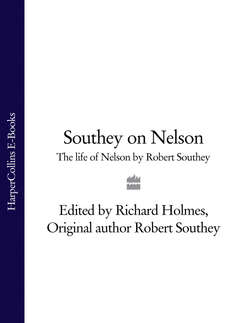Читать книгу Southey on Nelson: The Life of Nelson by Robert Southey - Richard Holmes - Страница 7
4
ОглавлениеFrom the time of his return to England in 1800, now aged forty-two and the hero of the Nile, Nelson found he had become a universal celebrity, cheered by crowds, dined by City corporations, and painted by leading artists. His small, tanned, hawklike figure; his glazed right eye and his one arm, and above all the mass of decorations he always wore on his dark blue naval greatcoat (he was wearing four stars at the battle of Trafalgar), made him instantly recognisable. He was mobbed wherever he went, whether boarding a cutter in Portsmouth harbour, dining with the mayor of Norwich, or simply shopping in Piccadilly.
After his death at Trafalgar a full-blown Nelson cult developed. It produced pictures, poems, songs, medals, statues, marble busts, waxworks, china mugs, and commemorative dinners. Pubs, streets and babies, were named after him; and Haydn composed a Mass in his honour. His fellow officers introduced the after-dinner toast, ‘To the Immortal Memory’, which is drunk in Royal Navy ward-rooms around the world to this day. In 1842 Nelson’s Column with its seventeen-foot high statue on top, was erected in Trafalgar Square.
This startling phenomenon has sometimes been compared to the aftermath of the death of Diana, Princess of Wales, in 1999. But it was far more deeply-rooted, in a sense of national pride, renewed identity and wartime achievement. Trafalgar was always understood as a defensive victory, not a conquest. It was the saving of Britain from foreign invasion, and hence an assertion of freedom, not of empire. It has perhaps more revealing analogies with the Battle of Britain of 1940.
The memory of Nelson compelled huge and lasting personal loyalty among all seamen, and tales of his exploits became legendary. For many men, contact with Nelson became in retrospect the defining moment of their lives. In a tiny Kentish churchyard, on the banks of the River Rother (which flows into the Thames estuary), I once stumbled upon a tombstone whose inscription read simply: “William Burke, Purser aboard his Majesty’s ship Victory, and in whose arms the immortal Nelson died.’
The witnesses of Nelson’s death are well-known to have been Dr Beatty, his surgeon, Dr Scott his chaplain, and Thomas Hardy, his ship’s captain. Yet the small, balding middle-aged William Burke did in fact support Nelson’s head during the three agonising hours it took him to die, kneeling down between him and the bulkhead, holding his shoulders in the dark, barely speaking a word. William Burke chose to record this moment in a perfect, but surely unconscious, iambic pentameter. The memory of Nelson had inspired the retired naval purser with a another fragment of English poetry, as a noble as an unwritten line from Shakespeare’s Henry V. ‘And in his arms the immortal Nelson died.’
